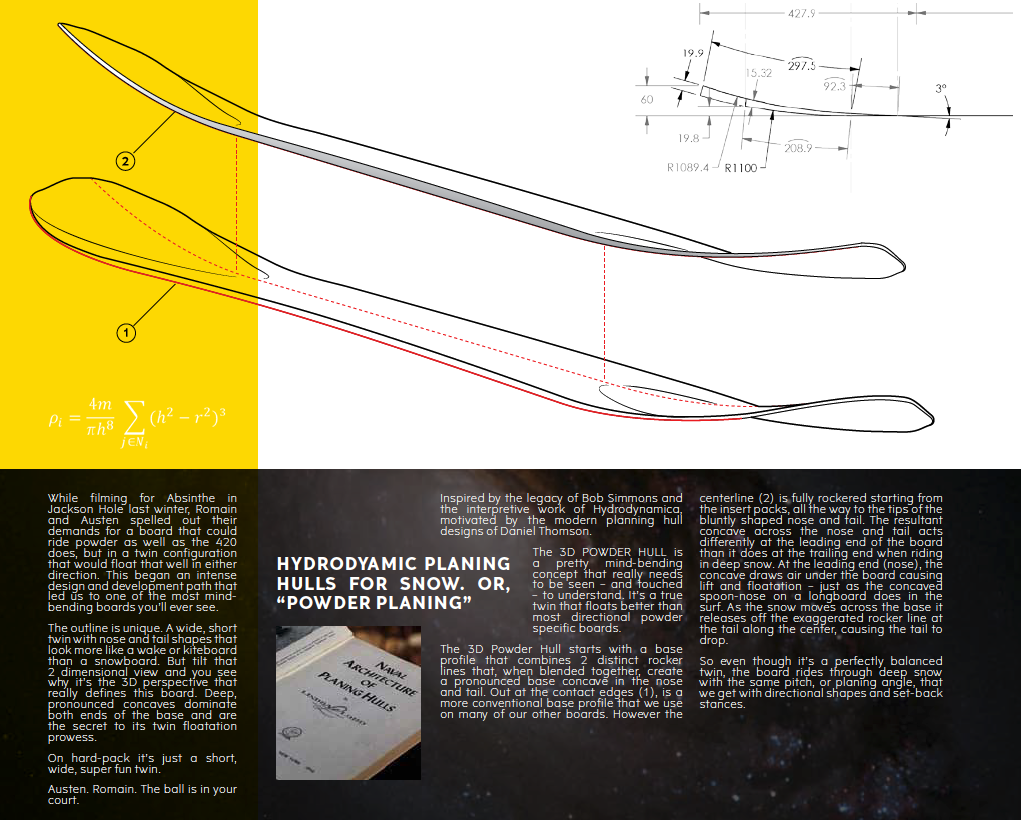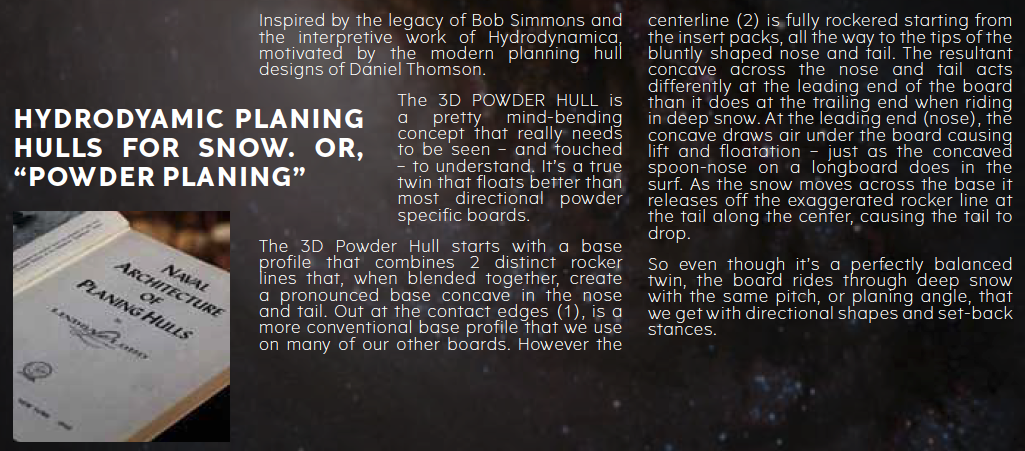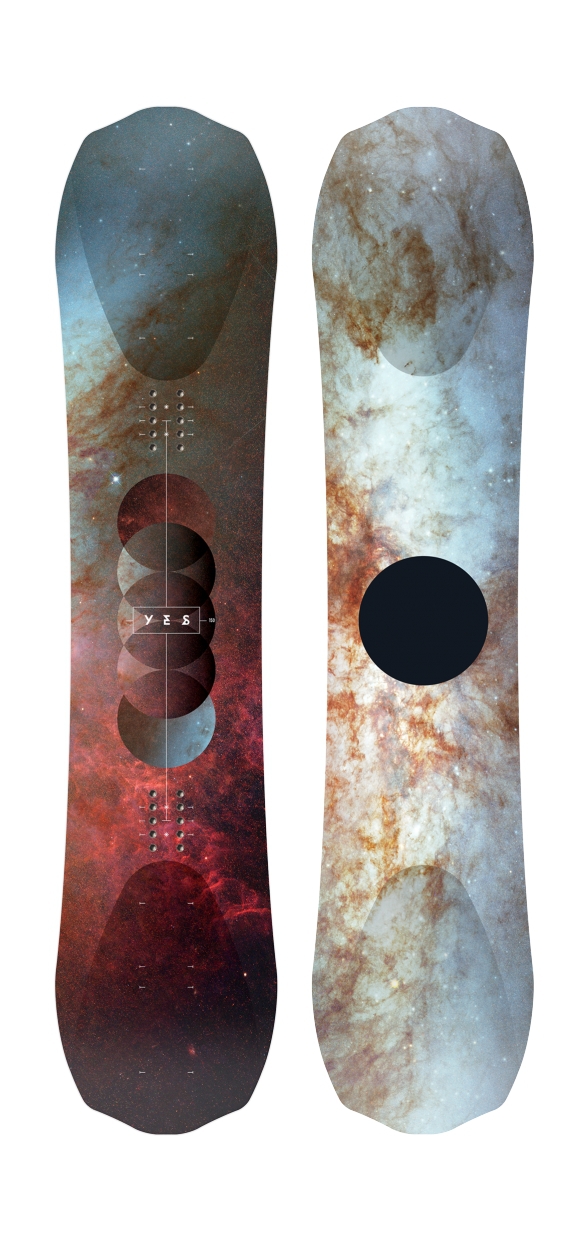YES. 20/20 Snowboard — 3D Powder Hull Explained
YES. 20/20 SNOWBOARD — 3D POWDER HULL EXPLAINED
While filming for Absinthe in Jackson Hole last winter, Romain and Austen spelled out their demands for a board that could ride powder as well as the 420 does, but in a twin configuration that would float that well in either direction. This began an intense design and development path that led us to one of the most mindbending boards you’ll ever see. The outline is unique. A wide, short twin with nose and tail shapes that look more like a wake or kiteboard than a snowboard. But tilt that 2 dimensional view and you see why it’s the 3D perspective that really defines this board. Deep, pronounced concaves dominate both ends of the base and are the secret to its twin floatation prowess. On hard-pack it’s just a short, wide, super fun twin.
Inspired by the legacy of Bob Simmons and the interpretive work of Hydrodynamica, motivated by the modern planning hull designs of Daniel Thomson.
The 3D POWDER HULL is a pretty mind-bending concept that really needs to be seen – and touched – to understand. It’s a true twin that floats better than most directional powder specific boards.
The 3D Powder Hull starts with a base profile that combines 2 distinct rocker lines that, when blended together, create a pronounced base concave in the nose and tail. Out at the contact edges (1), is a more conventional base profile that we use on many of our other boards. However the centerline (2) is fully rockered starting from the insert packs, all the way to the tips of the bluntly shaped nose and tail. The resultant concave across the nose and tail acts differently at the leading end of the board than it does at the trailing end when riding in deep snow. At the leading end (nose), the concave draws air under the board causing lift and floatation – just as the concaved spoon-nose on a longboard does in the surf. As the snow moves across the base it releases off the exaggerated rocker line at the tail along the center, causing the tail to drop.
So even though it’s a perfectly balanced twin, the board rides through deep snow with the same pitch, or planing angle, that we get with directional shapes and set-back stances.



God dammit, now I need/want one of these in my quiver as well, well played yes snowboards, well played indeed
That makes two of us. I’m so stoked on the 20/20. Even got to hold it in my hands at SIA. It’s a thing of beauty!
Does amine have any demo 20/20’s for bw members with a penchant for writing hilarious TV soap opera reviews and who’s first name starts with T to ride & review??? If yes, my hands up first!!!!!
Hey Jeremy ,thanks for hooking me up with the YES 2020.
I thought I would give everybody a bit of feedback. I just got back from Japan this week and this is my third YES board the other two being the 420 from the past two seasons. I thought the 2020 had some pretty high expectations to keep up with the 420, however it is better in every way, it floats extremely well, can handle bigger mountain terrain easily, rides chop very well, you can hit anything you like land switch, and the piece of resistance it rips up the trees like nothing else so if you want to ride tight trees they are not tight anymore on this board, it’s actually dangerous how fast this boards rides trees anyway I lived to tell the story without hitting one to hard. It’s very fast you literally smoke past everybody.
Hope you enjoy the video.
The Powder Hull is the future, i would expect to see it on more boards in the coming seasons
You weren’t wrong, @JimmyTheFox. ![]()
I initially really these boards and instantly wanted one BUT Ive been giving the idea of this powder hull some serious thinking during the drudgery of my current day job and im having some problems getting my head around some of what yes are explaining is happening with the shapes involved.
Now for starters IM NOT AN ENGINEER and i have no qualifications in fluid dynamics or the forces involved in ‘hydrodynamic planing” im just a bloke who likes to over think about things so id love to hear from someone who does have some knowledge in the type of sciences involved here and correct me!!!
I have no problems with the hull at the rear doing what they say, a dipping tail from the shape and what the snow is doing makes sense, but the fist thing im having trouble getting my head around this “At the leading end (nose), the concave draws air under the board causing lift and floatation”. With the speed a human travels on a snowboard in deep pow surely the amount of air being drawn underneath the surface area that nose shape has would have a negligble effect on lifting said humans weight and board.
My second concern is what that nose powder hull (now will be referrred to as PH) actually does to the shape of the snow being forced under it. As the board travels forward the snow comes in the PH & has a wide entry ‘hole’ but as the board travels over the PH shape contracts and therefore condenses/compresses the snow before its narrower exit ‘hole’ and then flat base. Wouldnt this condensing/compressing of a substance that sticks together like snow actually slow you down somewhat as the snow is mooshed into itself?? Then when it has no where to go at the end of the PH, it accumulates and then kinda act like a bulldozer pushing forward slowing you down again???
Im pretty sure I have an idea as to how planning works on a boat and how they have tried to apply it with this PH in the base but when boat hulls use the shape it travels the length of the hull. Also water has alot more drag and boats have an engine on the back applying huge forces that get a hull to get a planning lift.
Bah the more i think about it the more it can some make sense and then also seem to not make any.
Someone help me out here!!!!!!!!!!!!!!!!!
Good question, @trentradpants. I have sent your post to the higher powers and, hopefully, we will hear back with an official answer soon. I have given it some thought, and while I also have no qualifications in this area, I’ll share my assumptions with you to contribute to the discussion.
A board, let’s say a true twin as is the case here, with mass centred, only needs to tilt at the centre axis (nose to tail) to create lift via deflection. With forward motion in powder, the tilt deflects snow downwards which is what gives the board lift (and, admittedly creates some drag as all boards do).
The concave hull at the nose definitely draws in more air underneath compared to a board without a concave hull. It’s just like a whale moving through the water with an open mouth; it’s going to draw in more water. It’s this drawing of the air that begins to tilt the board. The same hull shape at the tail increases surface area enabling the deflected snow to blast out the tail faster, dropping the tail further, and increasing the tilt.
That’s essentially how we get boards to float in powder, correct? We “lean back” or “pressure the back foot” or use various shapes (tapers, setbacks, rockers) to make the nose rise and the tail to drop. In a similar way to how a kite or wings work, the tilt causes air, or in our case snow, to be deflected downwards, thus giving lift to the kite/plane/snowboard.
So I think your statement below is looking at in the wrong way:
With the speed a human travels on a snowboard in deep pow surely the amount of air being drawn underneath the surface area that nose shape has would have a negligible effect on lifting said humans weight and board.
I don’t think the effect of the nose hull is to lift the weight of the rider, but it’s designed to give lift to the NOSE of the board, which in turn tilts the board without effort, which in turn creates lift via deflection.
The 20/20 provides float for a few reasons: the natural tilt in either direction, width adding surface area, and the rocker/flat/rocker profile when looking down the centre of the board (it’s flat if looking down the edges).
I feel the entire design is intended to give an effortless tilt to the board, regardless of which directed you ride it. It’s this effortless tilt combined with the extra waist width (surface area), which allows this true twin to ride powder in both directions with a short length.
Hey @trentradpants - Although (sadly) I do not qualify as someone who has “knowledge of the type of sciences used here” I have infact ridden the 20/20, and I can certainly attest to the fact that the large scooped shape of the nose does promote lift in soft snow (by allowing more air to enter underneath the nose). Its quite noticeable, and as a result, this short twin board certainly feels very floaty in soft snow.
And @rider26 is absolutely correct with his response, the 20/20 is a TWIN, so the main purpose of this PH tech is to facilitate the board planing (in soft snow) just like a directional and/or tapered board (with an elevated nose and a sunken tail) which results in less rider leg fatigue to keep the nose comfortably afloat..
Although I concede that it would be hard for you to completely comprehend the tech without having used it, this PH tech definitely works! It is obviously suited to guys who love riding twins IN ALL CONDITIONS. And for them, it is like a ‘revelation’ that offers incredible POW float in a shorter centred board (which as you know, don’t really float that well in pow!!!!
Personally, I love taper in a board’s shape when there’s pow, so I am more excited about this tech gracing the new 420PH. This one gets my heart racing for sure!!!!!
Hope this helps!? CHEERS.
For what it’s worth, I tested the 20/20 146 last season on a deep Whistler pow day and was blown away by how well it floated in both directions. I was so impressed, that I purchased the 20/20 150 for this season in Whistler. I don’t get boards too often, and this was the one board I decided was at the top of my list. It is a super impressive snowboard, and I agree with Amine… It needs to be ridden to be believed. I couldn’t be more stoked!
It is obviously suited to guys who love riding twins IN ALL CONDITIONS. And for them, it is like a ‘revelation’ that offers incredible POW float in a shorter centred board (which as you know, don’t really float that well in pow!!!!
THIS!